After testing several portable power stations in the 500-600Wh battery range, I decided to get the Bluetti EB55 to find out how it performs compared to its competition.
Max’s conclusion: Excellent value considering its output/input power & LiFePO4 battery
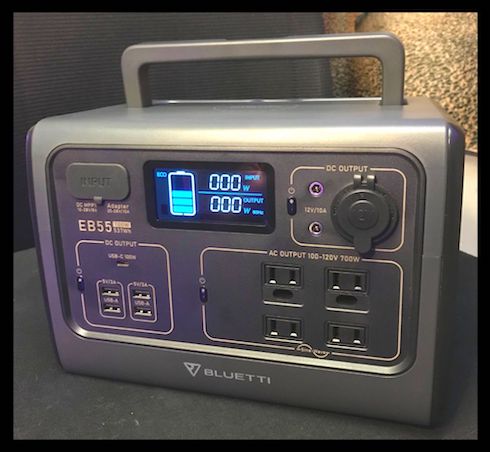
| + Likes | – Dislikes |
|---|---|
| High AC power output for its size | LCD screens shows battery life in 20% increments |
| Long-lasting LiFePO4 battery | Car charging & car output performed below listed specs |
| Relatively low price ($400-500) | Heavier than most Li-ion power stations (500-600Wh) |
The Bluetti EB55 is a valuable portable power station due to its long battery cycle life (2,500 cycles), powerful AC ports (700W continuous), and variety of output port options (13 total). It also has fast recharging times from both solar and AC recharging methods.
The EB55’s solar and AC inputs each take in a maximum of 200W, but you can also combine them for a total of 400W.
This “combined” method can recharge your EB55 in as little as 1.8 hours.
The Bluetti EB55 is best for people looking to have as much AC output power as possible without sacrificing portability. At 16.5 lbs, it is light enough for short-distance carry, yet its 700W continuous AC output can power several appliances that most 500Wh systems cannot.
Table of Contents:
- What are the basic specs of the Bluetti EB55?
- EB55 output ports & recharging times
- AC output testing
- USB output tests
- 12V DC output testing
- Solar charging the EB55
- Wall charging
- Car charging
- Bluetti EB55 vs. similar power stations
- Unique features of the EB55
- Would I get the EB55 over its competition?
Below are the basic specifications of this power station, and then I’ll follow with my actual testing results. At the end of this post is my YouTube video going over all of my results and tests.
What are the basic specs of the Bluetti EB55?
| Model/Specs | Bluetti EB55 |
|---|---|
| AC Output (Max) | 700W (1,400W surge) |
| Solar Input (Max) | 200W |
| Battery Capacity | 537Wh |
| Battery Cycle Life | 2,500 cycles to 80% capacity |
| Weight | 16.5 lbs |
| Dimensions | 10.9 x 7.9 x 7.8 in |
| Warranty | 24 months |
| Price (Subject to Change) | $500 |
| User Manual | EB55 manual |
The main aspects I look at to determine if a power station is valuable or not are:
- Battery cycle life: Is it higher than average?
- AC output power: Is it competitive amongst similar-sized power stations?
- Recharging speed: Does it recharge at a reliable rate?
- Price: Is it fair compared to similar models?
From the listed specs above, the EB55 is among the best in these core categories for solar generators ranging from 500-600Wh.
Below, I dive a little deeper into the output ports as well as recharging.
EB55 output ports & recharging times
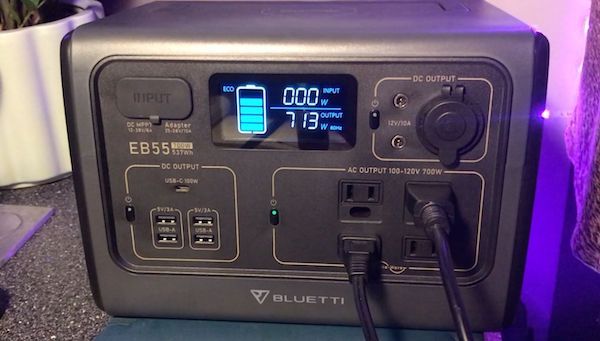
| Model | Bluetti EB55 |
|---|---|
| AC Ports | 4x AC ports (700W continuous, 1,400W peak) |
| 12V DC Ports | 1x DC car port (12V, 10A) 2x DC 5521 ports (12V, 10A) |
| USB & Wireless Ports | 1x USB-C port (100W max) 4x USB-A ports (15W max per port) 1x Wireless charging pad (15W max) |
| Charge Times | AC wall charger (200W): 3.2 hours Solar charging (at max input of 200W): 2.7 hours Car charging: 6 hours (12V), 3 hours (24V) AC + max solar (400W): 1.8-2.3 hours Dual AC chargers (400W): 1.8-2.3 hours |
Looking at the EB55’s capabilities on paper, it has some impressive characteristics. But do they all perform to specification in my testing? In short, nearly all of them do; however, I had two issues when testing it out where it didn’t perform as stated on paper.
AC output testing
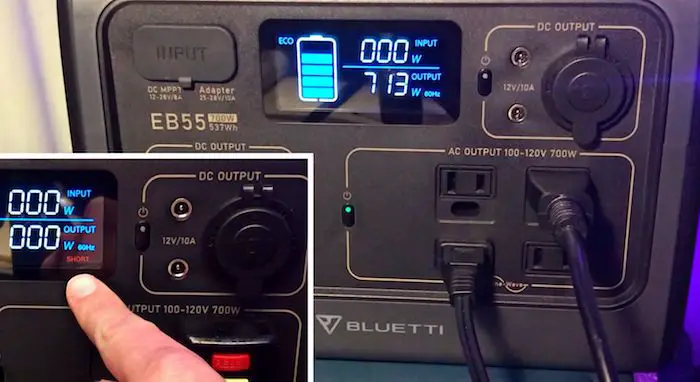
The EB55 is rated at 700W continuous with a 1,400W surge max. I successfully reached 700W continuously by using a small space heater and clothes steamer together with the model.
Prior to this odd combination of appliances, I tried using a high-powered hairdryer with it, but it failed to run once I reached the highest setting on the appliance. The power station showed a red message reading “SHORT” when it failed and I simply pressed the AC port button to reset the outputs.
Mind you, the hairdryer is rated for 1,875W, but I used it with my EcoFlow River Max and it worked at a much lower wattage than 1,875W. This may have to do with EcoFlow’s X-Boost technology, which can adapt its AC power output to run high-powered appliances at lower wattages.
For more information on this, I recommend checking out my review post on the River Max here: EcoFlow River 600 Review – Testing My River Max + Comparisons.
Overall, the EB55 power station can run appliances at 700W with no issues from my testing. But I wasn’t able to truly test the surge rating and get concrete evidence of its 1,400W surge maximum.
USB output tests
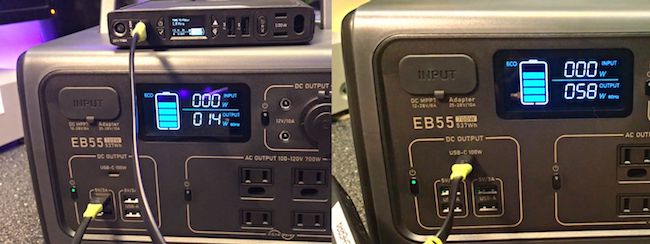
The USB ports on the EB55 were pretty straightforward in my testing. It has four USB-A ports that are capable of 15W each and a USB-C with up to 100W of output power.
I used my Sherpa 100AC power bank to test these ports since it displays input wattage.
My results:
- USB-A ports: All four outputted 14W
- USB-C port: Outputted 58W
The reason these didn’t output more watts is mainly due to my power bank. It only accepts a max of 12W from any USB-A port. In the EB55’s case, it outputted 14W but my Sherpa took in 12-13W max.
As for the USB-C port, the Sherpa only takes in a max of 60W from this charging source, so the EB55 worked successfully at 58W of output.
Overall, the USB ports worked almost to perfection with my power bank, but unfortunately, I didn’t have a device/appliance that could test its 100W USB-C output.
There is also a 15W wireless charging pad on top of the power station, but I didn’t have a compatible device to test it.
12V DC output testing
There are three output ports in this section:
- 1x car port
- 2x 5521 ports
I tested these ports individually and they both performed the exact same, at 106-107W continuously. These ports seemed like they were capable of more output power because they all dropped their power down from about 116W to 107W at the start of my tests.
Overall, the 12V outputs underperformed from their listed specifications. This could be due to some mistake from my own testing, but with multiple different attempts to get over 107W continuous, I wasn’t able to reach the EB55’s listed 120W output.
Solar charging the EB55
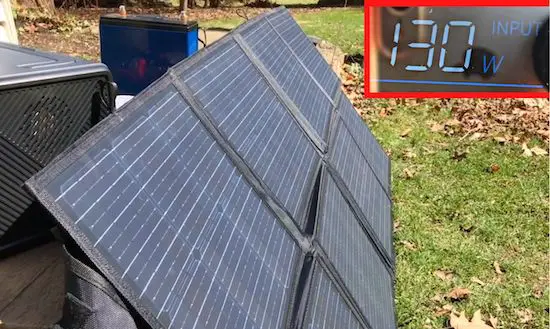
I tested the EB55 solar input with my Atem Power 200W solar panel. In my test, I got about 130W of max input.
At this rate, it would take 4.5-5 hours to recharge the EB55 from zero battery.
The power station didn’t make any noise while it was charging, but this was probably because it was 30°F outside and didn’t need to run its cooling fans.
If I test the power station again, it will be with my two Elecaenta solar panels because they each have 120W of power and would be able to get closer to the EB55’s 200W max input.
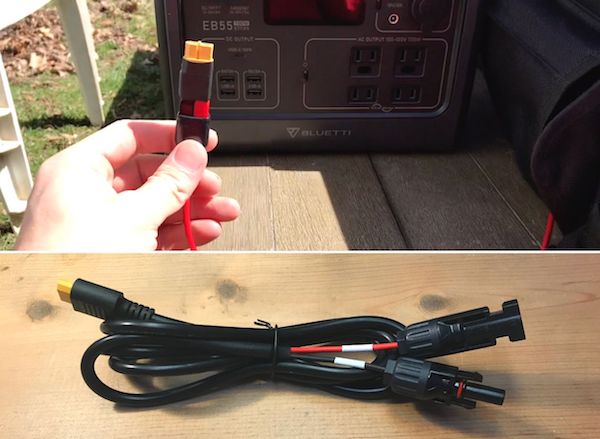
An important fact to consider is the solar input maximum of 28V/8A. When looking for solar panels to recharge this power station, I’d make sure that they stay within this range to get the best results.
Wall charging
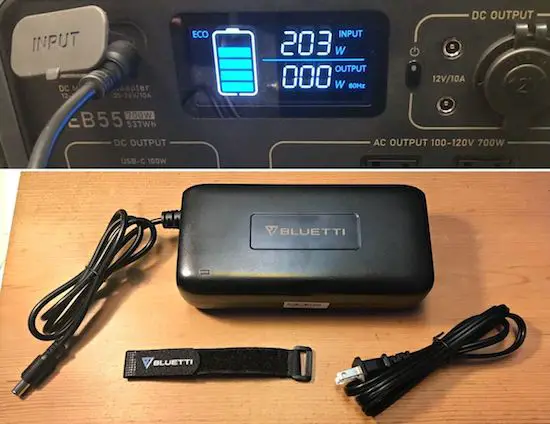
Wall charging was exceptional for this power station. It comes with a 200W charger, which worked exactly to the specification. This will recharge the EB55 in about three hours.
It’s important to compare this to other power stations in this 500-600Wh battery size range because there are several similar models that take much longer to charge from the wall. I’ll get into this in more detail when comparing the EB55 to similar models later on.
Car charging
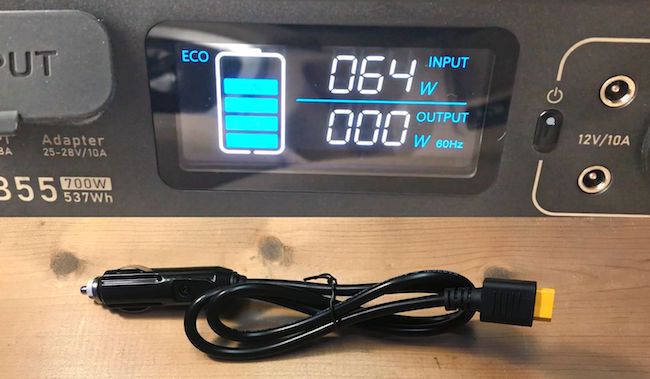
This test did not perform to its listed specifications. In the manual, it states that the power station will recharge from a 12V car battery at about 98W. In my own testing, the maximum wattage was 64W.
If you intend to recharge this from your car, it will take about four times longer than the other methods.
Bluetti EB55 vs. similar power stations
All of the models listed below have similar battery capacities. As you’ll see, each model has its own unique characteristics.
| Model | Bluetti EB55 | Goal Zero Yeti 500X | EcoFlow River 600 Max | Rockpals Rockpower 500 | Jackery Explorer 500 |
|---|---|---|---|---|---|
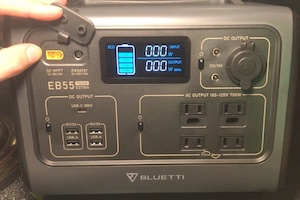 |  | 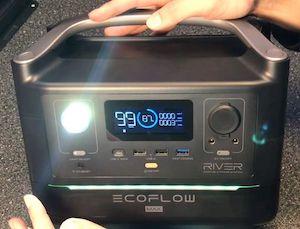 | 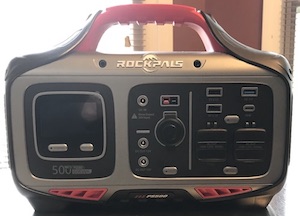 |  | |
| Battery Capacity | 537Wh | 505Wh | 576Wh | 505Wh | 518Wh |
| Price | $500 | $700 | $450-500 | $350-450 | $500-530 |
| Battery Cycle Life | 2,500+ cycles to 80% capacity | 500 cycles to 80% capacity | 500 cycles to 80% capacity | 500 cycles to 80% capacity | 500 cycles to 80% capacity |
| Output Ports | 4x AC ports (700W continuous, 1,400W peak) 1x DC car port (12V, 10A) 2x DC5521 ports (12V, 10A) 1x USB-C port (100W max) 4x USB-A ports (15W max per port) 1x Wireless charging pad (15W max) | 2x AC ports (300W continuous, 1,200W peak) 1x DC car port (12V, 10A) 1x 6mm port (12V, 10A) 2x Standard USB-A ports (12W max per port) 1x USB-C port (18W max) 1x USB-C PD port (60W max) | 3x AC ports (600W continuous, 1,200W peak) 1x DC car port (13.6V, 10A) 2x DC5521 ports (13.6V, 3A max per port) 1x USB-C port (100W max) 1x USB-A Fast Charge (28W max) 2x Standard USB-A ports (12W max per port) | 2x AC ports (500W continuous, 750W peak) 1x DC car port (12V, 10A) 2x DC5521 ports (12V, 5A) 1x USB-C PD input/output (45W max) 1x USB-A QC 3.0 (18W max) 2x USB-A ports (5V/3.1A max per port) | 1x AC port (500W continuous, 1,000W peak) 1x DC car port (12V, 10A) 2x 6.5 x 1.4mm ports (12V, 7A) 3x USB-A ports (12W max per port) |
| Recharging Times* | AC charger (200W): 3.2 hrs Solar @ max input (200W): 2.7 hrs Car charger: 6 hrs (12V), 3 hrs (24V) AC + max solar (400W): 1.8-2.3 hrs Dual AC chargers (400W): 1.8-2.3 hrs | AC charger (60W): 10 hrs Solar @ max input (150W): 3.4 hrs Car charger (120W): 4.5 hrs | AC charger (400W+): 96 min Solar @ max input (200W): 2.9 hrs Car charger: 6.5 hrs | AC charger: 7-8 hrs Solar @ max input (120W): 4.2 hrs Car charger: 7-8 hrs USB-C PD + AC charging: 4.3-5 hrs | AC charger: 7.5 hrs Solar @ max input (100W): 5.2 hrs Car charger: 7.5 hrs |
| Weight | 16.5 lbs | 12.9 lbs | 17 lbs | 12.3 lbs | 13.3 lbs |
| Individual Review | N/A | Goal Zero Yeti 500X Review | EcoFlow River Max Review | Rockpals 500 Review | N/A |
Since the amount of data listed above is complex as a whole, I compared the EB55 with each model individually below. However, there are two features that are equally compared amongst all models in this table:
- The EB55 has an LCD screen that is slightly lower in quality compared to the rest – This has to do specifically with the EB55’s battery status indicator. It only reads the battery levels in 20% increments. All the other models read the exact battery percentage, which makes them more user-friendly.
- The EB55 has a battery cycle life that lasts five times longer than all of the others – Its 2,500 cycles heavily outlast the other models’ 500 cycles.
Bluetti EB55 vs. Yeti 500X
Other than a similar-sized battery, nearly everything about these solar generators is different.
The Yeti 500X’s biggest advantage to the EB55 is its weight. Even though its battery is only about 30Wh smaller, the 500X weighs 3.5 pounds less.
The EB55 has better characteristics in all other fields. It has:
- Five additional port options
- AC ports that output over double the power of the 500X
- Faster recharging speeds from solar and wall charging
Lastly, the EB55 costs $200 less than the Yeti 500X, which is significant since the EB55 has better performance numbers as a whole.
EB55 vs. Rockpals 500
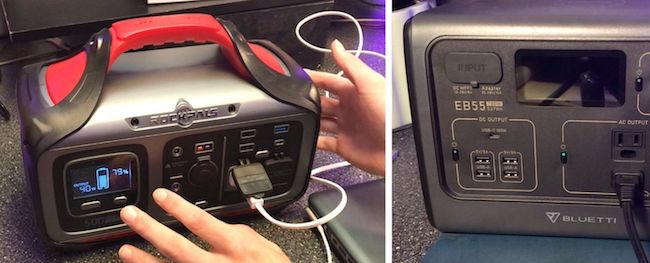
The Rockpals Rockpower 500 weighs 12.3 pounds, which makes it the lightest power station in my comparison (it’s over four pounds lighter than the EB55).
It’s also the least expensive power station on the list, at $350. Rockpals often has discounts available that make their power stations cheaper than their competitors. The Rockpower 500 can be an ideal budget option, costing $150 less than the EB55.
However, the performance of Bluetti’s power station as a whole is significantly better than the Rockpals 500. The EB55 has:
- Four additional output ports
- A higher-powered AC output (an additional 200W of continuous power)
- Much faster recharging times from wall and solar charging
If you’d like more details on the Rockpower 500, I suggest reading my own experience with it in my review post found here: Rockpals Rockpower 500 Review (Testing, Pricing, and More).
Jackery Explorer 500 vs. Bluetti EB55
Jackery is a well-known brand that keeps its power stations simple in design and function. Because of this, they’re highly user-friendly.
When looking at the Jackery Explorer 500 specifically, it is priced slightly higher (on average) than the EB55. It also has half the output port options compared to the Bluetti model (7 vs. 13).
Although it’s a lightweight power station, at 13.3 pounds, the Jackery 500 lacks fast recharging times when compared to the EB55.
The Jackery 500 was created several years before the EB55, and it has not been updated since its initial release. Although it still is a versatile power station, it doesn’t house any USB-C ports or fast-charging USB-A ports.
The Explorer 500 really isn’t competitive against the Bluetti EB55 because it lacks in several performance categories, yet it still costs the same price.
If you like Jackery’s power stations because of their simplicity, I recommend checking out their Explorer 300 because it comes with upgraded USB ports and it can fit in your backpack. You can read my review of it here if interested: Jackery Explorer 300 Review & Test (Plus Comparisons).
EcoFlow River Max vs. Bluetti EB55
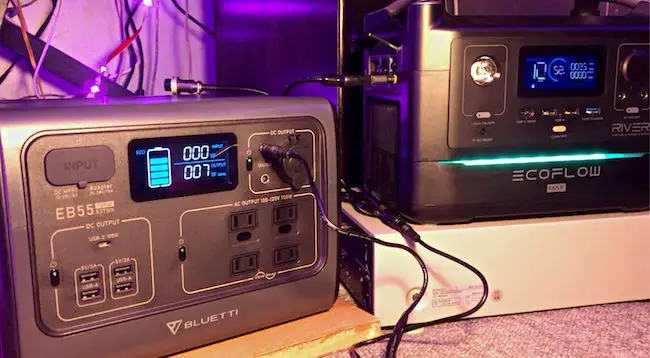
The River Max is the EB55’s closest competitor. They are both similar in price, with the EcoFlow River Max tending to be about $50 cheaper.
They also have very similar specs in the following categories:
- AC output (700W vs. 600W continuous) – Although the base wattage is similar, the River Max has a feature called X-Boost, which makes it capable of powering several appliances rated over 600W
- USB-C output (100W)
- Solar input (200W max) – Both power stations even use the same XT-60 connection for solar panel and car charging
- Weight (16.5 vs. 17 lbs)
The EB55 has three more output ports than the River Max, including an additional AC port, USB port, and a wireless charging pad.
The River Max, on the other hand, currently has one of the best AC recharging speeds of all solar generators on the market. It charges it in as little as 96 minutes from 0-100% battery. I’ve seen my own River Max charge at 450W from its included AC charger. This is over twice as much power as the EB55’s AC charger.
One additional feature that’s not mentioned in the table is the River Max’s mobile application. It connects to your phone or tablet via WiFi and you can use the app to adjust a significant amount of settings.
The one factor that makes the EB55 a serious contender against the River Max is its battery longevity. If you think of the fact that the EB55 will last five times longer than the River Max under the same conditions, then it can be hard to decide between the better model.
If you’d like to check out my review post of my own EcoFlow River Max, I highly recommend it. I personally really enjoy using this power station because of its advanced technology, which makes it customizable to your liking: EcoFlow River 600 Review – Testing My River Max + Comparisons.
Unique features of the EB55
There were a few features that stood out to me when analyzing the EB55:
- 2,500-cycle LiFePO4 battery: Lasts about five times longer than the standard li-ion power station
- 700W AC output: Most solar generators in this size category output only about 300-500W
- LED lantern (on the rear of the power station): Has three modes (50%, 100%, SOS function)
- Multiple recharging methods: Not only does it charge fast from AC and wall charging, but you can combine charging methods for twice the input power (up to 400W)
What is Eco mode on the Bluetti EB55?
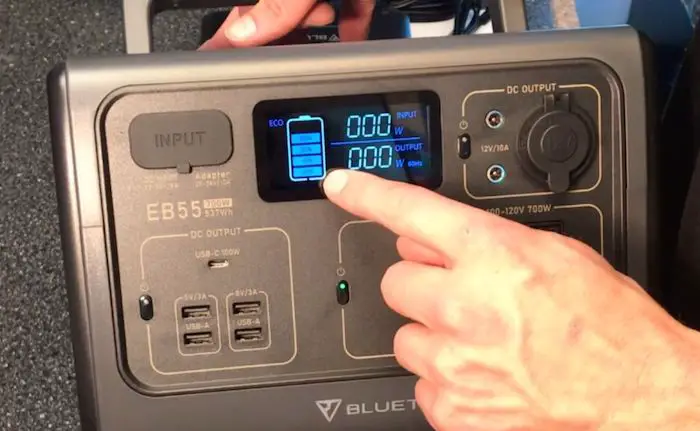
Eco mode automatically turns off the Bluetti EB55’s AC ports if they are consuming 20W of power or less after four hours. This is used to save battery life since the AC inverter consumes power even when the AC ports are not being used.
If you accidentally leave the AC port section on without using Eco mode, then the EB55 will consistently lose battery life until the AC ports are turned off.
You can switch the EB55 on and off of Eco mode, but I recommend keeping it on in most cases. My EB55 came with Eco mode already turned on, but if you want to turn it off, you can do so by following the manual’s instructions. I also show you how to do this in my YouTube video at the bottom of this post (at 30:48).
Would I get the EB55 over its competition?
Yes, I would get the EB55 over the other options I compared. The EB55 has a battery that will last five times longer than the others, which makes it more valuable in the long run.
The power output on the EB55 is as good as the EcoFlow River, and the solar input is also the same as the River. The River connects to an app on your phone and allows you to customize all sorts of settings, but I find that these settings aren’t entirely necessary for my own needs (although they are really cool and can be useful for many people).
If the EcoFlow River was built with a longer-lasting battery, I would probably choose it over the EB55. However, its lithium-ion battery lasts for 500 lifecycles (to 80% capacity), which is the same amount of cycles as the other three models mentioned in the comparison.
As for your own power needs, here are my recommendations when trying to decide which is best for you:
- I would get the EB55 over the Yeti 500X and Jackery Explorer 500 without question. The EB55 costs less and has better specs in nearly every category.
- The Rockpals Rockpower 500 costs much less than the others on this list and it’s also the lightest power station. I’d get this one over the EB55 if you wanted the best budget option.
- I’d get the EcoFlow River Max over the EB55 if you want the most advanced customization settings. Although it doesn’t have the EB55’s LiFePO4 battery, it’s just as powerful and recharges fast.
- If battery longevity is more important to you than high-tech features, then the EB55 is the best option. It’s also the best long-term budget option since it will outlast the others.
My YouTube review of my EB55 goes into all of my tests and analysis, some of which were not discussed in this post. You can check it out below.
